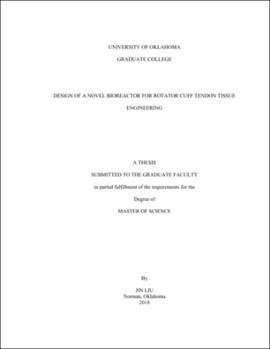| dc.description.abstract | Rotator cuff tears are a common cause of pain and disability due to injury and degradation of rotator cuff tendons. More than 250,000 patients require surgery each year, a majority of whom are over the age of 40. The current surgical treatments include tendon reattachment with surgical suture and graft transfer. It has been reported that the suture repair surgery has failure rates estimated between 20% and 70%, and the failure rate increased linearly with increased tear size. Thus, rotator cuff tendon repair remains a challenge in orthopedic surgery. Tissue engineered tendons, aiming at mimicking the intrinsic properties of natural tendons, have a great potential to replace the damaged human tendon. We propose a novel solution to engineer rotator cuff tendon by using the human amniotic membrane (hAM) as a scaffold with adipose-derived stem cells as a cell source. Cyclic mechanical stimulation is one of the key factors in tendon tissue engineering as it has been shown that it promotes tenocyte differentiation and mechanical properties of the tissue graft. The goal of this study is to develop a novel bioreactor that provides a tissue culture environment and controllable force and strain based mechanical stimulation.
Most of the current tendon tissue engineering bioreactors in use are custom made. Custom made bioreactors are less costly and more suitable for the tissue samples compared to the commercial bioreactors. Most of the custom made bioreactors provide strain based mechanical stimulation. One issue with strain based bioreactor is that some scaffold materials deform under certain mechanical stimulations. When deformation happens, the sample length changes, and the percent strain will not be precise anymore. Also, the initial position of the tissue sample in the bioreactor is not well calibrated. It is impossible to adjust the tissue sample position precisely by human eyes. Since stretch displacement is often in millimeter range, the imprecise initial position will cause an inaccurate mechanical stimulation. Thus, a bioreactor system is designed with three programs to address these issues. A pre-stretch program is developed to adjust the tissue sample to any required position precisely. A strain based stretching program is used to provide cyclic mechanical stimulations with a constant strain and force monitoring. If the force decreases over time, it suggests that the tissue sample deformed and the strain is no longer accurate. In this case, a force based stretching program could to used instead to provide a constant force based mechanical stimulations to the tissue sample.
Furthermore, the variability of the mechanical properties of hAM was also studied with the use of a strain based program. The results show that hAM samples processed with the decellularization protocol have a consistent mechanical property at different positions. An extra 1.5% strain is suggested to added the tissue sample as the initial position before applying mechanical stimulation. | en_US |
